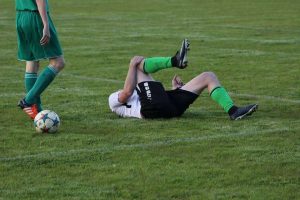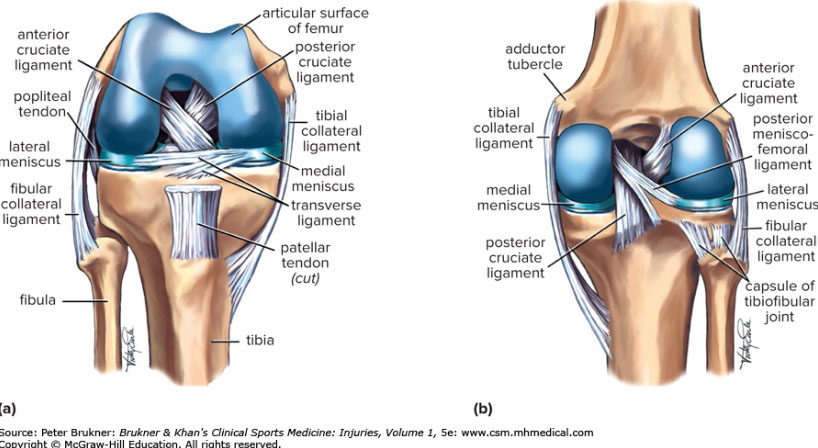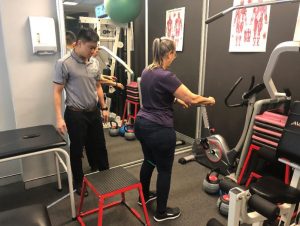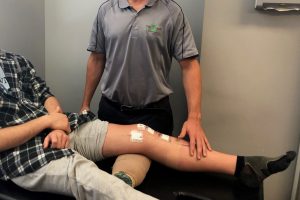ACL Tear – What Do You Do?
Your opponent tries to get past you. As you turn to chase them, your foot stays planted. You hear a “pop”. Immediate pain is felt. You scream out as you fall to the ground and grab your knee “what the hell just happened?”
Unfortunately, this is one of the typical stories we hear after someone has just sustained an ACL injury.

What is the Anterior Cruciate Ligament?
The Anterior Cruciate Ligament (ACL) is one of the main ligaments contributing to knee stability. Its purpose is to limit the anterior or forward translation of the tibia (shin bone) on the femur (thigh bone) and controls rotational movement of the knee, assisting in functional stability of the knee. ACL tears can be complete or incomplete, and they can occur in isolation or in combination with injuries to the meniscus, articular cartilage or Medial Collateral Ligament (MCL). If an ACL injury is suspected, a comprehensive physiotherapy assessment and rehabilitation program is essential either in preparation for surgery (and Post-op Recovery) or to help restore movement and function in those opting for non-operative conservative management.

Mechanism of the ACL Injury
The ACL is often torn as a result of a non-contact injury involving a cutting/stepping manoeuvre or single leg landing movement. Typically, the foot is planted with the knee slightly flexed and collapses inwards placing the knee in an awkward position leading to ACL failure. Alternatively, injuries may occur after landing awkwardly from a jump, after stopping suddenly or following a direct blow to the knee following a collision.

Signs and Symptoms of an ACL injury
- A “pop” is often heard
- Rapid and excessive swelling
- Immediate pain which is often coupled with an inability to continue activity
- Loss of knee movement
- A feeling of “giving way” or instability when weight bearing
Risk Factors
- Sports involving pivoting/cutting/stepping
- Female (16-30) = 2.4 to 9.7x higher risk
- Inadequate hip/knee biomechanics
- Poor jump/hop scores
- Returning to sport prior to rehab completion or not meeting discharge criteria
- Returning to sport before 9 months following an ACL reconstruction

What do you do if you suspect an ACL injury?
- Initial Ice, compression, and elevation can help immediately and often crutches are required to help keep you mobile.
- A physio appointment ASAP is recommended. A thorough examination from our team of experienced physiotherapists is usually sufficient to diagnose an ACL tear. The sooner this is done the better, both to direct management and get you moving freely again.
- An MRI is routinely requested to confirm diagnosis. MRI’s may be bulk billed with a GP referral.
- Referral to an orthopaedic knee specialist is often sought for an opinion on whether conservative or surgical management is required.
- Continue with physio for early injury management, pre-op rehab and complete ACL recovery whether it is managed conservatively or following surgery.
Physiotherapy is an essential component at all points of rehabilitation following an ACL Injury.

What are the Benefits of Early Physiotherapy management?
Early Physio management is beneficial in order to gain an accurate diagnosis. Our team has the ability to arrange scans/imaging where needed as well as coordinate orthopaedic specialist appointments in a timely manner (where appropriate). We have a great working relationship with some of Sydney’s best knee specialists and can generally arrange appointments for our patients that require urgent attention within a couple of days.
Starting Physio Management early helps to:
- Restore normal gait/walking pattern
- Get relief from initial symptoms
- Reduce swelling
- Establish full range of motion
- Improve muscle activation and strength
- Analyse and correct biomechanical faults
- Improve recovery time if conservative or non-operative management is undertaken
- Build baseline strength and recover faster after operative management
- Reduce re-injury rates
- Improve long term outcomes/return to sport
Many surgeons recommend physio prior to surgery to ensure full range of motion and optimal muscle strength and control, setting up patients for success and helping them achieve the best post-operative prognosis and results.


Do I have to have surgery?
Not always. If your knee is stable (not giving way) and you are able to return to normal functional and sporting tasks with physiotherapy rehabilitation, then surgery is not always indicated. We work closely with the orthopaedic specialists to determine a conservative vs. operative management plan based upon patient goals and functional requirements.
On occasion the specialist may want to trial conservative non-operative management before committing to surgical intervention.
Why?
Well if you do well with rehabilitation alone and improve your muscle control and strength, leading to a stable knee that doesn’t give way, then you may no longer require an operation. If this is the case, you’ll be back to doing what you love in no time, but if not, surgery can still be undertaken. This is reinforced in a study by Zadro and Pappas 2018 showing a cultural shift away from early surgery and towards non-surgical management, with surgery “as needed” if required.

What does the evidence say?
Evidence shows that physiotherapy before and after surgery leads to better outcomes and reduced risk of graft failure. Failla et al (2016) found that the addition of 10 extra pre-op physiotherapy sessions lead to significantly better knee function and higher levels of return to pre-injury sport level. Grindem et al (2016) further supported this with a 5 week pre-operative strengthening program leading to better knee function at 2 years follow-up. Additionally, Eitzen et al (2009) found quads strength greater than 80% pre-operatively was associated with significantly better knee function at 2 years follow-up after ACL surgery. Surgeons also report a quicker recovery and overall better outcome in their patients who have limited swelling and full extension prior to surgery (Brukner and Khan, 2012). Both Kyritsis et al (2016) and Grindem et al (2016) demonstrated post-op physiotherapy based on return to sport criteria significantly reduced the risk of re-injury.
There is a growing body of research supporting conservative management as a viable option for ACL ruptures. Frobell et al (2013), recommended that their research “results should encourage clinicians and young active adult patients to consider rehabilitation as a primary treatment option after an acute ACL tear.”
Meuffels et al (2008) supports this with a 10 year follow up of conservatively managed patients showing no difference compared to ACL reconstruction patients with regards to osteoarthritis, activity level and functional outcomes. In 2008 Hurd et al found at 10-year follow-up, 43% of patients deemed suitable for conservative management had resumed and maintained high level activities. There is also the potential in professional athletes to return to competition without an ACL and this was demonstrated by Weiler et al (2015 & 2016) reporting a case study on an English Premier League footballer who returned to competition without surgery in 8 weeks following an ACL tear and further to this he remained symptom free at 18 month follow-up. Rugby League player Peter Wallace and basketballer DeJuan Blair are other examples of professional athletes competing without an ACL. Perhaps, significantly, there is no study at a group level that shows you can’t return to pivoting sports!
So, what does all this evidence mean?
In a nutshell, it suggests that people that do pre-operative physiotherapy get a better post-op functional outcome. It also suggests that some people can recover extremely well with physiotherapy lead conservative management alone, avoiding surgery all together. Overall, physiotherapists are best placed to lead rehabilitation including strengthening exercises, neuromuscular control, balance and sports specific training, assisting patients achieve the criteria for safe return to sport and normal everyday function.
Have you injured your knee and are concerned it could be your ACL?
GET AN ASSESSMENT & TREATMENT WITH OUR AMAZING PHYSIO TEAM.

- Get a crystal clear diagnosis on what’s causing your pain or injury
- Understand what activities you can do without suffering further consequences of knee pain
- Commence rehabilitation improving your mobility and helping you get symptom free
- Set out a management plan so that you can achieve the best results
- Leave the session with the confidence of knowing exactly what to do to help you get pain free and back to sport, activity and full function

